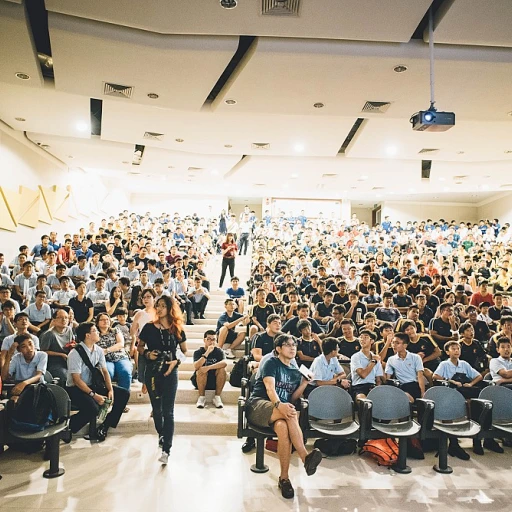
Understanding the Role of AI in Employee Termination
The Role of AI in Streamlining Employee Termination
In the evolving landscape of human resources, artificial intelligence is increasingly playing a pivotal role in managing complex processes, including employee termination. Businesses are turning to AI to streamline the termination process, ensuring it is efficient and compliant with company policies. This modern approach allows companies to handle terminations with a level of precision and consistency that was previously challenging to achieve.
AI tools can help business owners and HR teams by analyzing employee performance data, identifying patterns of poor performance, and providing insights into the reasons for termination. This not only aids in making informed decisions but also helps in maintaining transparency and fairness in the process. By learning from historical data, AI can suggest the most appropriate time for a termination meeting, ensuring it aligns with both business needs and employee considerations.
Moreover, AI can assist in managing the logistical aspects of firing someone, such as ensuring the return of company property and the accurate calculation of severance pay and final paycheck. This reduces the administrative burden on HR teams and minimizes the risk of errors during the termination process.
While AI offers numerous advantages, it is crucial for companies to balance automation with empathy. The human aspect of termination cannot be overlooked, and AI should be used as a tool to support, not replace, the human touch in these sensitive situations. As we explore the ethical considerations and legal aspects in subsequent sections, it becomes evident that a thoughtful integration of AI into HR practices can significantly enhance the overall termination process.
For small businesses, leveraging AI can be particularly beneficial. It allows them to operate with the same level of sophistication as larger organizations, ensuring that employee terminations are handled with care and professionalism. As AI continues to evolve, its role in HR will undoubtedly expand, offering new opportunities for improving employee management and business operations.
For more insights on how AI can enhance HR operations, consider exploring resources on enhanced HR operations.
Ethical Considerations in AI-Driven Terminations
Ethical Concerns in Automating Dismissals
Employee termination is a sensitive task, and while AI can streamline the process, ensuring ethical practice is crucial. Balancing company policies with empathy helps in maintaining morale and company culture during challenging times. Ethical concerns arise when automation, such as in firing employees, overshadows personal touch, which is invaluable in such processes. Ethical AI deployment in terminations is not just a matter of technological capability. It involves understanding that behind every termination, there is a person. Automation might seem efficient, but the personal and emotional aspects of firing someone remain profoundly human. Transparent communication during a termination meeting, following established company policies, helps demonstrate respect for the employees' dignity. Traditional processes allow business owners to consider the individual's circumstances, poor performance, or reasons for dismissal in detail. Thus, utilizing AI must not eliminate the necessity for human oversight. AI in assisting termination processes should be a tool to help decision-makers, providing data-driven insights and predicting outcomes rather than replacing the need for human judgment. Maintaining this balance ensures fairness and integrity. Involving AI in any termination process also requires constant updates in algorithms to avoid biases that could lead to wrongful terminations. These biases can be unintentional but may seriously affect the employee being evaluated. Developing AI systems with considerations for equality and fairness is therefore vital. Lastly, it’s imperative for companies to continuously monitor and adjust AI systems to align with both legal standards and the ever-evolving corporate ethics landscape. Learning and improving these systems can benefit employees and businesses alike, fostering a fairer work environment. For more on how generative AI solutions can aid in enhancing ethical practices during employee policy searches, check out enhancing employee policy search with generative AI solutions.AI Tools and Technologies for Effective Termination Processes
Embracing Technological Tools in the Termination Process
Artificial intelligence is playing an increasingly pivotal role in navigating complex processes, including the challenging task of terminating employees. In modern business landscapes, a variety of AI tools and technologies can bring about significant improvements to termination processes, ensuring a smoother transition for everyone involved. One of the primary benefits AI offers is the ability to analyze data effectively. Many companies utilize AI-powered analytics to assess employee performance over time. When someone exhibits poor performance, these tools can provide objective insights that support the reasons for termination beyond subjective opinions. However, businesses must ensure that their AI systems remain unbiased and adhere to existing company policies. Automation can greatly assist in managing the practical aspects of termination. From generating documentation to scheduling termination meetings, AI can streamline these often time-consuming tasks. Companies can use AI platforms to send automatic notifications to both the employer’s team and the employee facing termination, reducing the administrative workload associated with firing someone. Business owners find these tools not only save time but also minimize human error during processes. Another significant area where AI can 'help' is aligning termination protocols with company policies and legal frameworks. Modern AI systems can help HR professionals ensure compliance with legal standards during the termination process. This alignment is crucial, especially for small businesses that may not have extensive legal teams at their disposal. For more insights into AI's role in HR compliance, consider exploring AI's Role in HR Compliance: A Deep Dive into Modern Practices. Nevertheless, while AI can support the logistical aspects of termination, the human element cannot be ignored. Combining both AI-driven efficiency and human empathy is essential to handle these situations sensitively, highlighting the need for a balanced approach in terminating employees respectfully and professionally.Balancing Automation and Empathy in Termination
Harmonizing Automation with Human Compassion
The integration of AI in the employee termination process can be a double-edged sword. On one hand, automation allows companies to streamline the procedural aspects, from ensuring that all company property is returned to calculating final paycheck details accurately. On the other hand, it's crucial to ensure that the human element remains at the forefront, as the process of firing someone is inherently personal and sensitive.
Balancing automation and empathy begins with acknowledging the reasons for termination. Faced with difficult decisions like firing an employee due to poor performance or policy violations, it's essential for business owners and HR teams to approach these conversations with care. Automation can handle logistical elements, but the delivery of the message should always involve a human touch.
Here are some tips to achieve this balance:
- Utilize AI for Scheduling: Automated systems can help schedule termination meetings at a time that works best for everyone involved, ensuring that both parties are prepared.
- Support Decision-Making: AI can provide insights into an employee’s performance over time, helping businesses identify the right reasons to fire someone, yet the decision to terminate an employee should never be entirely left to automation. Human oversight is critical.
- Empathetic Communication: While AI can offer templates and script suggestions for termination meetings, it’s crucial that these meetings are conducted by a human, who can respond to emotions and questions with empathy.
- Offer Support: Once the decision to terminate is made, AI can help in organizing resources for the employee. This includes severance pay logistics or support in finding new opportunities, ensuring the process remains as supportive as possible.
AI's role is to help the process become more efficient and less prone to errors, but the empathy and understanding required in these situations are distinctly human traits. By keeping the focus on the person who is being let go, companies can maintain respect and dignity for the employee, even in difficult termination scenarios. Businesses must also ensure that they operate within the bounds of company policies and legal frameworks to avoid potential repercussions on social media and beyond.
Legal and Compliance Aspects of AI in Termination
Legal Framework and Compliance in AI-Driven Employee Termination
Navigating the legal and compliance landscape in AI-driven employee termination is crucial for businesses aiming to incorporate advanced technologies into their human resources processes. Ensuring that AI tools align with existing laws and company policies is essential for protecting both the company and the employees involved. AI can certainly help streamline the termination process, but it's important for business owners and HR teams to closely examine employment laws that govern firing practices. This includes understanding the reasons an employee termination might be contested, such as claims of wrongful termination or discrimination. Legal preceding should be thoroughly integrated into the AI algorithms guiding these decisions.- Employment Law Adherence: AI systems used in firing an employee must be calibrated to understand and respect the nuances of employment laws specific to the region in which the business operates. A misstep could result in legal challenges or damage to the company's reputation.
- Data Protection and Privacy: Personal employee data used by AI for performance analysis or reasons for termination must comply with data protection legislation. Ensuring that sensitive information is securely managed can prevent breaches and maintain employee trust.
- Severance Pay and Final Paychecks: AI helping manage the termination process should also account for the legal requirements surrounding severance pay and final paycheck disbursement. Compliance here prevents any financial disputes and ensures a smooth transition for terminated employees.
- Monitoring Bias and Fairness: One of the ethical considerations discussed earlier must translate into legal oversight. AI mechanisms should be regularly audited for bias to ensure fair treatment of all employees, regardless of background.
Future Trends: The Evolving Role of AI in HR
AI Integration: Shaping the Future of Employee Termination
The role of artificial intelligence in the realm of human resources is continually evolving, particularly in the sensitive area of employee termination. As businesses strive for efficiency, AI tools are becoming more prevalent in managing termination processes. But the question remains: how will AI reshape the future of terminating employees?
Firstly, the usage of AI technology in this context allows for more data-driven decision-making, ensuring that terminations are based on clear, objective criteria. This could potentially reduce biases and uphold the integrity of company policies. Performance analytics can be significantly enhanced through AI, providing a clearer picture of why a termination is necessary, whether due to poor performance or other valid reasons.
In addition to data analysis, AI can streamline the administrative aspects of termination processes. Automating the scheduling and documentation of termination meetings can be a huge help to HR teams, ensuring consistency and compliance with labor laws. However, it's crucial for businesses not to lose sight of the human element in these decisions. As AI takes a more active role, maintaining empathetic communication becomes essential to preserving employee morale even during a termination process.
While AI offers numerous advantages, it must be implemented with caution. Business owners should balance AI efficiency with the need for empathy in delivering news of termination. It's important to remember that while AI can provide support, it must not replace the human touch required in firing someone. Consequently, HR professionals will need to remain at the helm, ensuring that AI tools complement rather than replace their efforts.
As we move forward, a key trend will be the integration of AI with other HR technologies to create more sophisticated systems. The synergy between man and machine in HR can lead to more holistic employee management strategies, where AI-driven insights contribute to better workplace dynamics, extending beyond the termination process. Companies that adapt to these technological advancements will likely find themselves at the forefront of efficient, empathetic human resources practices.












